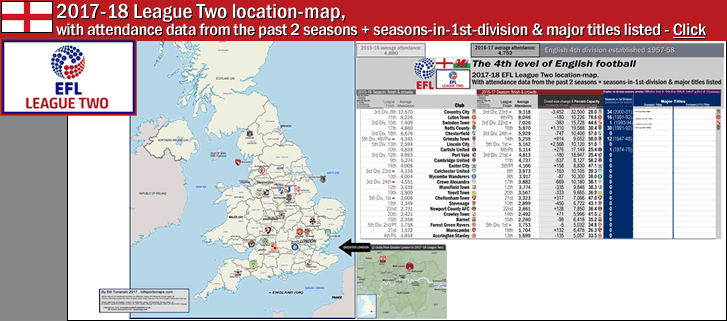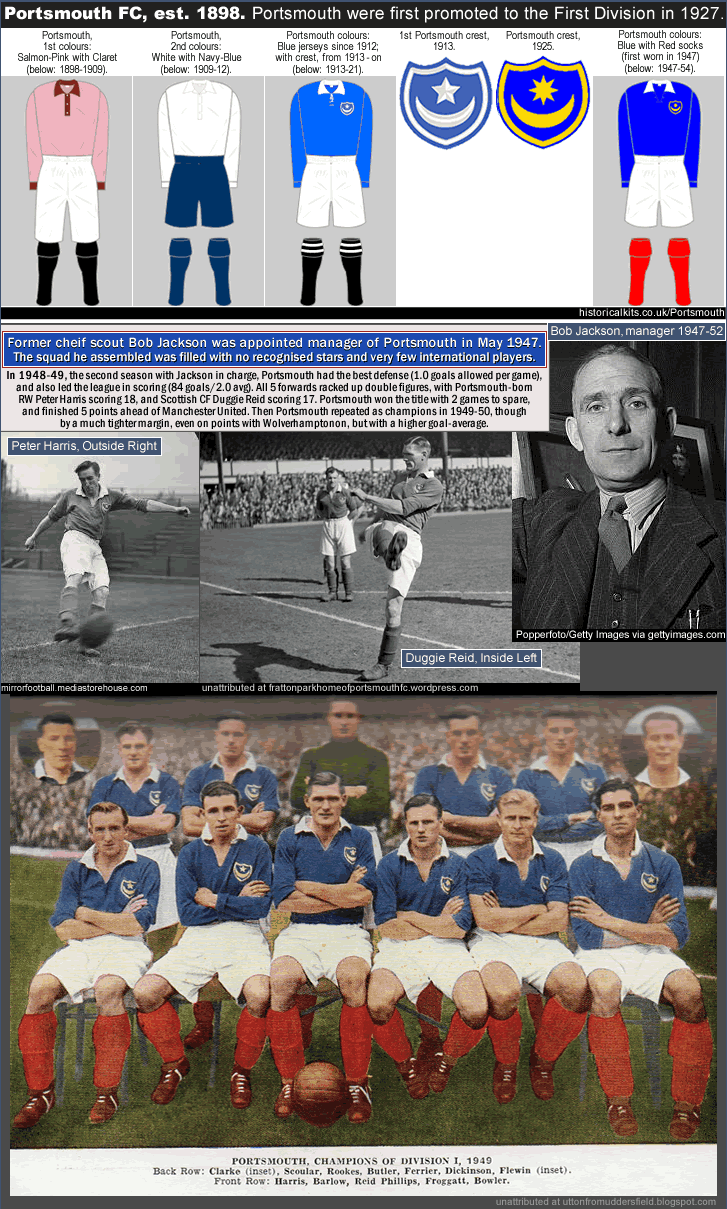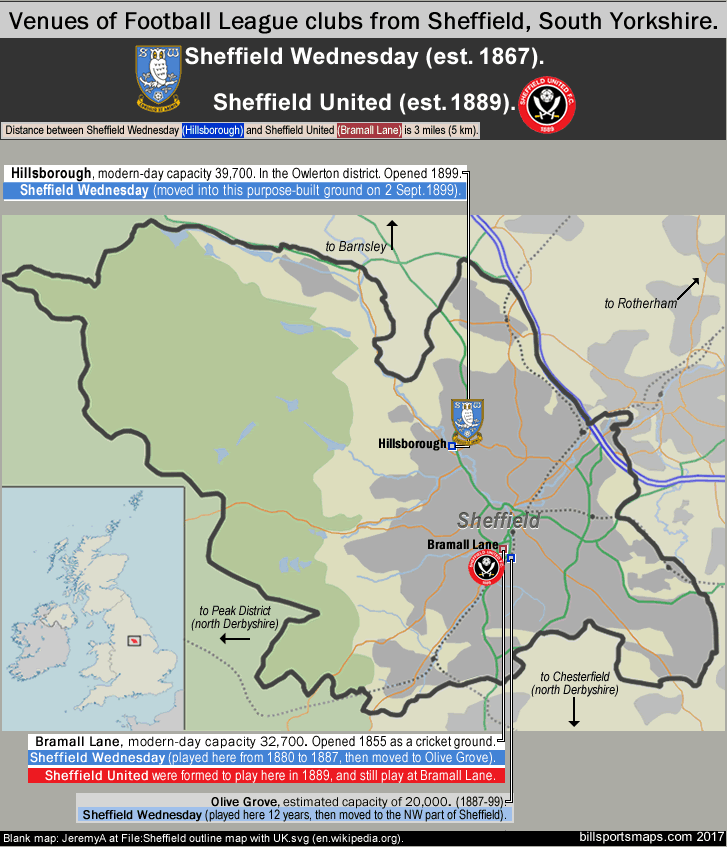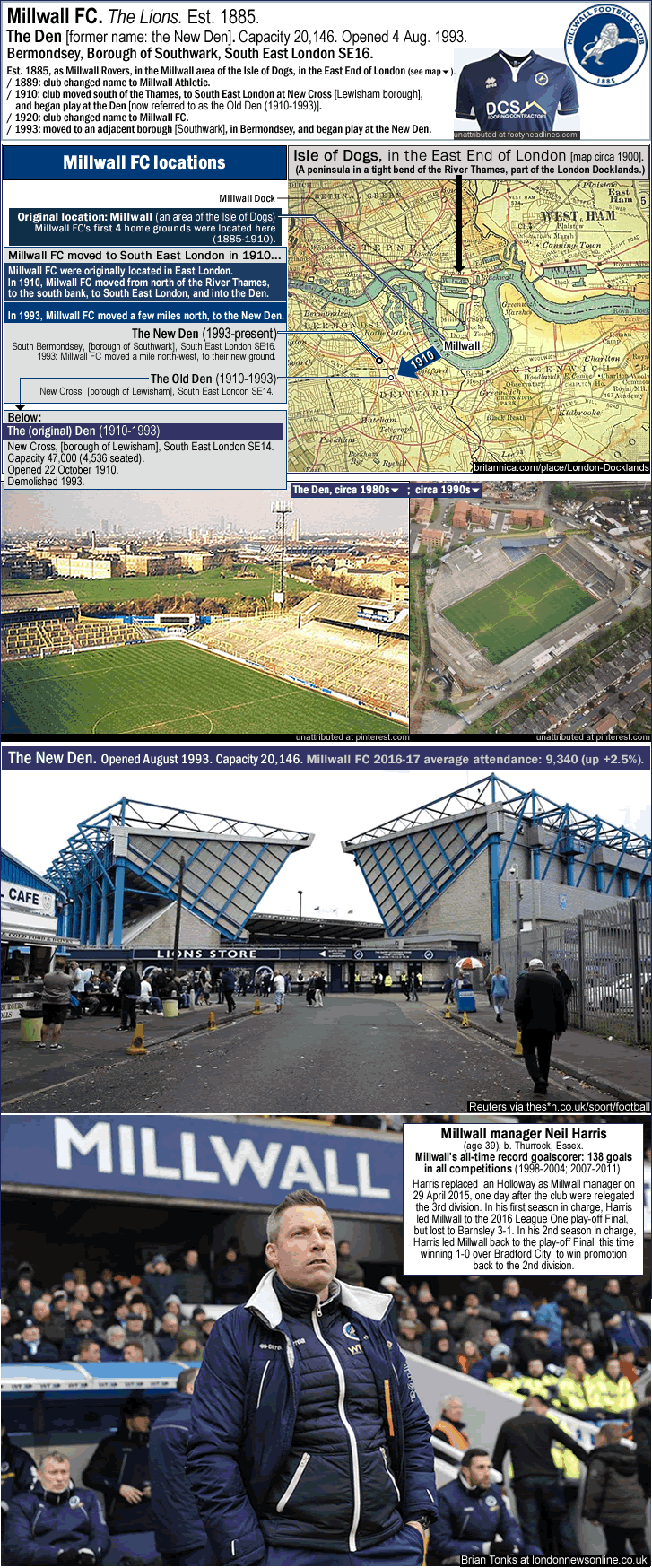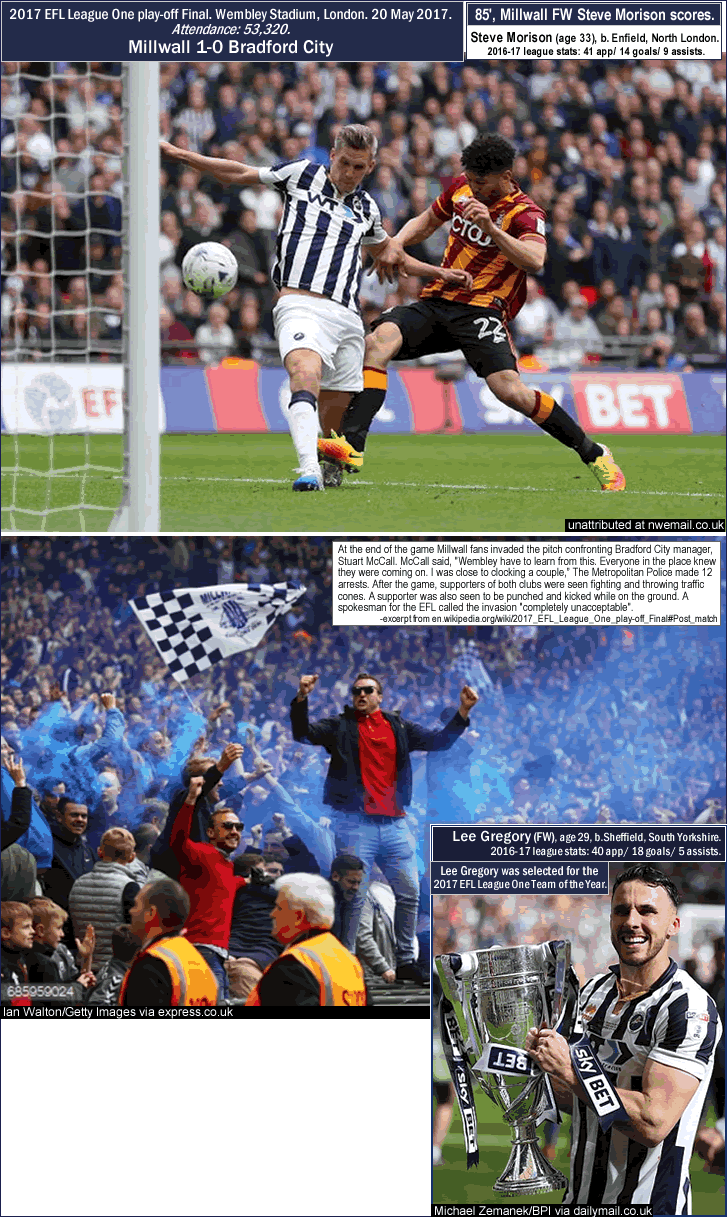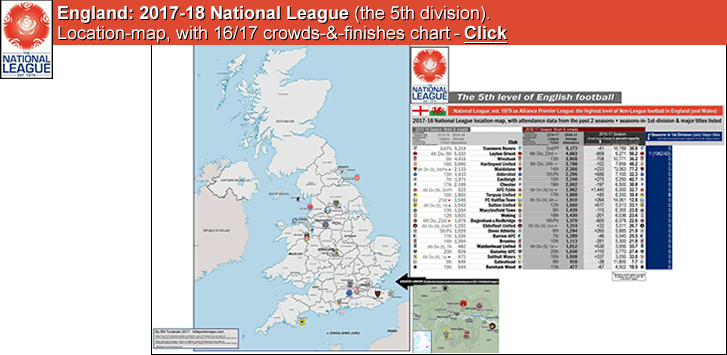
2017-18 Premier League (1st division England, including Wales) – location-map with chart with: 16/17-crowds-&-finish + titles-&-seasons-in-1st-division
…
…
By Bill Turianski on 17 July 2017; twitter.com/billsportsmaps.
Links…
-2017–18 Premier League (en.wikipedia.org).
-Table, fixtures, results, attendance, stats…SUMMARY – Premier League [2017-18] (us.soccerway.com).
-theguardian.com/premier-league.
-Kits…Premier League 2017 – 2018 (historicalkits.co.uk).
A brief re-cap of 2016-17…
Champions…Chelsea: under their new manager Antonio Conte, Chelsea won the 2016-17 English title with ease, clinching with 2 games to spare and finishing 7 points above Tottenham.
Teams that qualified for Europe…Champions League Group Stage: Chelsea, Tottenham, Manchester City, Manchester United (via winning Europa League title). CL GS play-off round: Liverpool. Europa League Group Stage: Arsenal. EL GS 3rd qualifying round: Everton.
Teams that were relegated to the 2nd division…Hull City, Middlesbrough, Sunderland.
Teams that were promoted from the 2nd division to the Premier League…the 3 clubs profiled below…
Below: illustrated articles for the 3 promoted clubs
(Newcastle United, Brighton & Hove Albion, Huddersfield Town)…
Newcastle bounced straight back to the Premier League as 2016-17 EFL Championship winners. Brighton & Hove Albion finished in second and won the other automatic promotion to the Premier League, meaning Brighton will play in the top flight for the first time in 34 years. Huddersfield Town won the 2017 Championship play-off Final at Wembley, beating Reading 0-0/4-3 in penalties; this means Huddersfield will play in the top flight for the first time in 45 years…
•Newcastle United FC.
Est. 1892. Nicknames: the Magpies; Geordies; the Toon (or the Toon Army). Colours: Black-&-White [vertically-striped jerseys]. Location: Newcastle-upon-Tyne, situated (by road) 289 miles (465 km) N of London; and situated (by road) 98 miles (158 km) N of Leeds. Population of Newcastle: metro-area population of around 1.6 million (6th-largest in the UK) {2011 census}.
NUFC, est. 1892: location, colours, nicknames…
Newcastle United are from Newcastle upon Tyne, in the county of Tyne and Wear. Newcastle is the 6th-largest metro-area in the UK (with a population of around 1.6 million). Newcastle is located in the north east of England, a few miles inland from the North Sea, about 30 miles south of the Scottish border, and 15 miles north of their hated rivals, Sunderland AFC. {NUFC and SAFC contest the Tyne and Wear derby/ Newcastle vs Sunderland: Why is the Tyne-Wear derby such a big deal? (by Luke Edwards at telegraph.co.uk/football, from Dec. 2014).}
Newcastle wear Black-&-White [vertically-striped jerseys], and have done so since 1894 {since their 3rd year of existence/see NUFC home-kit-&-crest-history (historicalkits.co.uk)}. Newcastle are nicknamed the Magpies (magpies, a large bird from the Corvid [crow] family, have black-and-white feathers). Newcastle United, and especially their local supporters, also go by the name Geordies (a term dating back to the 18th century, see this, Geordie/Etymology). There is a third moniker for NUFC (and their fans), and that is Toon (or Toon Army)…Toon is how Geordies (Newcastle-area locals) pronounce the word “town”. {See this, quora.com/Why-is-Newcastle-United-called-Toon-Army.}
Newcastle United: a gigantic club, with cobwebs in their trophy cabinet…
‘The club has been owned by Mike Ashley since 2007, succeeding long term chairman and owner Sir John Hall. The club is the seventeenth highest revenue producing club in the world in terms of annual revenue, generating €169.3m in 2015.’ {-excerpt from en.wikipedia.org/wiki/Newcastle_United_F.C.}. Newcastle’s stadium, St James’ Park is the 7th-largest football venue in England (seated capacity: 52,405; last expanded in 1998-2000). Newcastle United have a gigantic fanbase, and usually draw between 49-and-52-K. Newcastle are the sixth-highest-drawing club in England (after Manchester Utd, Arsenal, West Ham Utd, Manchester City, and Liverpool).
Newcastle United have 4 English titles and 5 FA Cup titles to their name, but they have not won a major domestic title in over 60 years…no domestic titles since 1955 (1955 FA Cup title). (Though Newcastle did win an international title in 1969 – the Fairs Cup, which was the predecessor to the UEFA Cup/Europa League.) So, I’m not gonna say it – but this guy will…Newcastle United – Specialists in failure (by Matt North on 13 Feb. 2015 at themag.co.uk [the Independent voice of Newcastle Utd since 1988]).
Newcastle United have been relegated from the Premier League twice in the last 8 years (in 2009 and in 2016)…
Newcastle have been relegated twice in the last 8 years, but have immediately bounced back from the 2nd division both times. In 2009-10, they won the 2nd division easily (by 11 points), under current-Brighton-manager Chris Hughton. But then they sacked Hughton half a year later, despite being a just-promoted side which was sitting in 11th place in the Premier League in mid-December of 2010 (see more on this time-period in the Chris Hughton part of the Brighton & Hove Albion section, further below).
Newcastle finishd in 12th that season (2010-11). The following season, under Alan Pardew, Newcastle finished 5th, and it looked like Newcastle were on the cusp of returning to the solid form they had in the early years of the 2000s (when they qualified for the Champions League in 2002 and in 2003, under Sir Bobby Robson). But the next season the bottom fell out, the atmosphere poisoned, and Newcastle finished in 16th place…they went from competing for a Champions League spot to a relegation-scrap in less than 12 months. Newcastle finished in 10th place the following season (2013-14), but it was much worse than it looked on paper, because the team ended the season losing 15 of their last 21 Premier League matches, and the Toon Army heaped further abuse on Pardew. A website called SackPardew.com was created. However, Pardew maintained the support of owner Mike Ashley into the following season (2014-15), but then Pardew jumped ship to Crystal Palace in January 2015…“with assistant manager John Carver taking over until the end of the season. He presided over some of Newcastle’s worst ever league form, including a run of eight consecutive defeats. A win over West Ham on the final day of the season ultimately secured Newcastle survival.” {-excerpt from 2014–15 Newcastle United F.C. season}. Overrated manager Steve McClaren was hired by Newcastle in June 2015. Bad move. By March 2016, Newcastle were in jeopardy of relegation, with only 24 points from 28 Premier League matches (an all-time club low). And this, despite the fact that Newcastle had spent about £100m in the past two transfer windows (Aug. 2015/Jan. 2016).
Enter Rafael Benitez as manager, replacing the sacked McClaren on 11 March 2016. But it was too late, and Newcastle went down to the 2nd division as 19th-place finishers, despite going 3 wins/4 draws/3 losses under Benitez. The one bright spot was that Benitez, who won two Spanish titles with Valencia, the Champions League and the FA Cup with Liverpool, and who could get a top flight job in most any league on the planet, decided to stay with the project at Newcastle. So in 2015-16, under Rafa Benitez, Newcastle won automatic promotion straight back to the top flight by winning the EFL Championship (edging out Chris Hughton’s Brighton, for the 2nd division title, on the last day of the season). Newcastle were in the automatic-promotion-places virtually the entire season. And they actually drew about 1.7-K-per-game higher in the 2nd division last season than they did 2 seasons ago in the Premier League (51.0 K in 16/17 versus 49.7 K in 15/16). Stand-out players for Newcastle in their successful promotion-campaign of 2016-17 were midfielder/playmaker Jonjo Shelvey, and striker Dwight Gayle, both of whom were selected to the EFL Championship Team of the Year {see photos/captions of both Shelvey and Gayle, further below}.
Newcastle United, 1st-place-finishers in the 2016-17 League Championship (automatic-promotion to the 2017-18 Premier League)…

Photo and Image credits -
NUFC 2016-17 jersey, photo from u90soccer.com. Aerial shot of St James’ Park, photo unattributed at pinterest.com. sc. Distant-exterior shot of Newcastle with St James Park in background, photo by Getty Images at gettyimages.com jpg Exterior/panorama shot of St James’ Park, photo unattributed at openbuildings.com. Exterior/close-up shot of St James’ Park, photo by Getty Images via chroniclelive.co.uk. Toon fans outside St James Park, pre-match, photo unattributed at themag.co.uk/the-siege-of-st-james-park.
Jojo Shelvey gives shout-out to cheering Toon fans, photo by Reuters via hitc.com/poll-who-is-the-best-centre-midfielder-in-the-championship jpg. Jonjo Shelvey, photo by Getty Images via express.co.uk/football. Dwight Gayle celebrating goal with teammates, photo unattributed at chroniclelive.co.uk/football. Inset: Dwight Gayle after an away-goal, photo by Reuters via the s*n. Rafael Benitez with players, celebrating away win at Brighton (Feb. 2017), photo by Bryn Lennon/Getty Images Europe via zimbio.com. Screenshot of image from video in caption-form [chant by Toon fans mocking Mackems/Toon fans as NUFC clinch promotion], image by mirror.co.uk/football. Newcastle players celebrating in dressing room after clinching promotion, photo by Getty Images via the s*n.
…
• Brighton & Hove Albion FC.
Est. 1901. Nickname: the Seagulls. Colours: Blue-&-White [vertically-striped jerseys]. Location: As the crow flies, Brighton & Hove is situated 47 miles (76 km) S of central London/By road, Brighton & Hove is situated 77 miles (123 km) S of central London. Population of Brighton & Hove: city pop., around 273,000/ metro-area pop., around 769,000 (15th largest in UK) {2011 census figures}.
-From the Guardian.com/football, Brighton’s long march ends in Chris Hughton’s completion of a job well done
- Twenty years ago it looked all over but an unflappable manager, a sparkling French winger and special team spirit have taken them back to the promised land (by Nick Miller on 18 April 2017 at theguardian.co.uk/football/blog).
Question: Why is the city (and the club) called Brighton and Hove ?
Answer: “The towns of Brighton and Hove formed a unitary authority in 1997 and in 2001 were granted city status by Queen Elizabeth II. “Brighton” is often referred to synonymously with the official “Brighton and Hove” although many locals still consider the two to be separate towns.” (-excerpt from en.wikipedia.org/wiki/Brighton_and_Hove). Also, Brighton & Hove Albion’s original ground, the Goldstone Ground (which the club played in from 1902 to 1997), was located in the town of Hove (and not in Brighton), so the club has always gone by the Brighton & Hove moniker.
Brighton & Hove Albion were founded in 1901…
Brighton & Hove Albion played in the Southern League for two decades before they and the rest of the 1919/20 Southern League Division 1 were absorbed into the Football League as the new Third Division, in 1920-21. Since then, overall (and counting 2017-18), Brighton has played 91 seasons of League football, with the vast majority of its Football League seasons as a 3rd division side – 53 seasons in the 3rd division, most recently in 2010-11 {all-time Eng. Div. Movement (1888-2016), here at rsssf.com}. Before 2017-18, Brighton had only played 4 seasons in the 1st division, and that was in one 4-year spell in the early 1980s.
Before 2017-18, Brighton & Hove Albion had only played 4 seasons in the English 1st division (1979-80 to 1982-83).
Brighton drew decent as a First Division team in the 1979-to-’83 time period, averaging 19.1 K per game, in that four year span {source: E-F-S site}. But the Seagulls never reached the top-half of the table in that 4-season stint, and 34 years ago, the frustration of finishing in last place in the First Division in 1982-83 was compounded by the fact that Brighton made it to the FA Cup Final that season, only to lose to Manchester United 2-2/0-4 in the replay {1982-83 FA Cup Final (en.wikipedia.org)}.
In the following 13 seasons, Brighton gradually slid down the divisional ladder, and fell into the 4th division, in 1995-96. The 1996-97 season in the fourth tier was the start of the club’s most difficult period. Not only were the Seagulls in jeopardy of losing their League place, but the club had severe financial problems, and owners that were only looking for profits…profits at the expense of the club itself (see next paragraph). Brighton were at one point 13 points adrift that season, and only avoided relegation out of the 4th division of the Football League by drawing with Hereford United on the final match of 96/97.
But for the Brighton faithful, their troubles were far from over. Because right at this point in time (spring of 1997), ownership sold their home, the Goldstone Ground, to developers (it is now the site of a row of retail outlets including a Toys R Us and a Burger King). In 1997, the mephistophelian owners of Brighton & Hove Albion (Greg Stanley, Bill Archer, and David Bellotti), sold their ground and pocketed the money… despite the team having NOWHERE ELSE TO PLAY. And the local council in Hove did nothing to stop this outrageous act. So Brighton & Hove Albion were made homeless – by their owners. (There was precedent for the local authorities to stop this, because, back in the mid-1980s, the local government in southeast London where Charlton Athletic play effectively saved Charlton Athletic from becoming homeless…“[The local council] told the builders they could build whatever they wished but not until [Charlton Athletic] had played their first league fixture in their new stadium, obviously never built, in the same borough. The ground stood derelict for a number of years while Charlton played at Palace and West Ham, before the developers realised they had been outfoxed and sold the ground back to a now solvent club. So why didn’t Hove Council do the same thing? It was all legal and above board, yet not one local political figure even suggested such a move.”…{-excerpt from Still missing the Goldstone Ground from 2007 at worthingherald.co.uk}.)
Thus began Brighton & Hove Albion’s homeless years – 14 seasons without a ground…
-Here is a youtube video, 20 REMARKABLE YEARS AT BRIGHTON & HOVE ALBION (3:43 video uploaded by Official Brighton & Hove Albion FC on 24 April 2017 at youtube.com).
First Brighton played two seasons at Gillingham’s charmless Priestfield Stadium in Kent (from 1997-to-’99), which was an unworkable 75 miles away. Then for 12 long seasons, they found accommodation at a local municipal venue, one that was completely unsuitable. That was the much reviled Withdean Stadium, which was a converted athletics facility that still had a running track, and which seated only 7-K, and which was not at all suitable for a Football League team, let alone any Non-League club worth its salt. The stands at the Withdean were at a shallow incline and were, thanks to the stupid running track, over 50 feet from the touchline {here is a shot of the North Stand at the Withdean}. In 2004, the Withdean was declared, by the Observer, the 4th-worst Football League venue {see this, Simply the worst, by Gemma Clarke on 9 Oct. 2004 at theguardian.com/football)}.
In 1998, the site for Brighton’s new venue at Falmer was identified. (Falmer is located 5 miles north-east of central Brighton.) But delays in getting planning permission kept pushing the start of the construction back. Meanwhile…“Because of the cost of the public enquiry into planning permission for a new stadium, rent on Withdean Stadium, fees paid to use Gillingham’s Priestfield Stadium, and a general running deficit due to the low ticket sales inherent with a small ground, the club had an accumulated deficit of £9.5 million in 2004.” {-excerpt from Brighton & Hove Albion F.C./Stadium (en.wikipedia.org)}. This debt was paid up by late 2005, which was also when the planning for the Falmer project was approved. Another delay set the project back even further, when it was revealed that some of the projected venue’s parking lot would be in the adjacent town of Lewes. Finally, construction of the Falmer Stadium began in 2008. A year later, in May 2009, new ownership (and the cash to fuel the ambitious new stadium project), came into Brighton and Hove Albion: Brighton-born property-investor/-pro-poker-player/-bookmaker Tony Bloom. “Since 2009 Bloom has been the chairman of Brighton & Hove Albion…/…He succeeded Dick Knight after securing a 75% shareholding in the club and investing £93 million in the development of the club’s new ground, the American Express Community Stadium at Falmer.” {-excerpt from en.wikipedia.org/wiki/Tony_Bloom}.
So instead of the early-to-mid-2000s, it wasn’t until the summer of 2011 that Falmer Stadium was completed…
As you can see in the illustration further below, Falmer Stadium is breathtaking. The venue, with a 30-K-capacity, is both space-age and fan-friendly. Through some asymmetrical design features (see 3rd stadium-photo below), it avoids the cookie-cutter look that afflicts some modern football stadiums in England (like Bolton’s stadium). And Seagulls fans have responded to the long-sought-after venue by producing some of the largest attendances in England outside of the top flight…
20.0 K in 2011-12,
26.2 K in 2012-13,
27.2 K in 2013-14,
25.6 K in 2014-15,
25.5 K in 2016-17,
27.9 K in 2016-17.
Basically, the only perennially-2nd-division club that has drawn higher than Brighton in the last half-decade (2012-13 to 2016-17) has been Derby County, and even so, Brighton drew highest in the 2nd tier in 12/13 and 13/14. Now that they have a proper football ground again, and after a 34-year absence from the 1st division, Brighton’s return to the top flight in 2017-18 will probably end up producing a percent-capacity figure above 95%.
Manager of Brighton: Chris Hughton (age 58).
Chris Hughton was born in Forest Gate, Essex (which is now situated in East London), the mixed-race son of a Ghanaian postman. Hughton was a left-back, making 361 league appearances (with 12 goals). Because of Irish roots on his mother’s side, Hughton was able to play for the Republic of Ireland (1979-91), with 53 caps (and 1 goal). Hughton’s whole pro playing career was spent with London-based clubs…primarily with Tottenham Hotspur (1977-90), but also with West Ham, and then with Brentford, the latter being where he hung up his boots in 1993. Hughton had always been a bit different than most footballers, and that manifested itself early on in his football career, in the late 1970s, with a sideline as a writer for the Workers Revolutionary Party (UK). These days, as it says in his Wikipedia page, Hughton plays down the Trotskyist aspect of that gig, saying “it’s probably not as dramatic as it sounds. I’ve always had strong views on social issues such as hospitals – I think we should have a good health system – and the education system, too…These days, players can do as many interviews and columns as they want. Back in the day, it wasn’t like that. Anyway, I’m sure I wrote about football and football issues. Nothing else.”. Be that as it may, Hughton has retained his left-wing convictions – he is a member of the Labour Party.
After retiring from the pitch, Hughton got into coaching and returned to Tottenham…
Hughton was in the Spurs coaching set-up for 14 years (June 1993 to October 2007) – first as the U-21 team coach, then the reserves coach, then as first team coach in 2001. Serving under 10 different managers, Hughton also had 2 short stints as caretaker-manager with Spurs back then. He lost his job when Spurs’ boss Daniel Levy sacked both him and manager Martin Jol, after Spurs fell to Spanish minnows Getafe in the UEFA Cup, in October 2007. Hughton then was hired by Newcastle United 5 months later, in February 2008, again as a first team coach. This was during the last reign of Kevin Keegan, who at that point could not hack it, so when Keegan bailed out, in September 2008, Hughton got his third gig as a caretaker-manager. That did not work out, and he was replaced by the bonkers Joe Kinnear (Newcastle were particularly tumultuous back then, and ended up relegated in that 2008-09 season). As the season wore on, in desperation, Newcastle tried out another former-hero-who-ended-up-a-managerial-flop (Alan Shearer), and were relegated to the 2nd division as 18th-place-finisher that season. Then owner Mike Ashley once again went back to Hughton. This time, in the 2nd tier in 2009-10, things clicked for the calm-and-preparation-focused Hughton, and after back-to-back Manager of the Month awards, he was hired as Newcastle’s full-time manager in October 2009. Newcastle easily won promotion straight back to the Premier League on 5 April 2010, finishing 11 points above the 2nd-place-finishers (West Brom). Then in 2010-11, with Hughton as a top-flight manager for the first time, Newcastle did well enough in the first-40-percent of the season. But Ashley and the Newcastle top brass didn’t think so, and after the team lost to West Bromwich 3-1, they sacked Hughton, in December 2010…when Newcastle, a just-promoted-team, were in a respectable 11th place (what?). The move was widely condemned by the vast majority of observers, and by a significant amount of Newcastle fans…“Before the match against Liverpool, on 11 December, campaigners from United For Newcastle organised a protest outside St James’ Park as an opportunity for supporters to thank Hughton and to show their anger towards Ashley’s decision.” {-excerpt from Chris Hughton (en.wikipedia.org)}.
But Hughton landed on his feet, and after being linked to many clubs, he signed on with just-relegated Birmingham City in the summer of 2011. Hughton led Birmingham to a 4th place finish in the 2011-12 League Championship, but the Blues lost to eventual promotion-winners Blackpool, in the play-off semifinals in May 2012. When Birmingham gave him permission to talk to other clubs, Hughton was hired by then-top-flight-side Norwich City, in the summer of 2012. In 2012-13, inheriting a team that finished 12th in the top flight, he kept the Canaries at about the same position, finishing in 11th. That was actually Norwich City’s best finish in 24 years (since 1988-89). But the following season, Norwich reverted to their all-too-frequent relegation-embattled mode, and Norwich dismissed Hughton when the Canaries sat 17th, in early April 2014 (Norwich went down that season as 18th-place finishers).
Brighton hires Hughton after a disastrous start to their 2014-15 season…
Through the 2014 off-season, several upper-division clubs then offered Hughton a job as the second-in-command, but Hughton held out for a gaffer’s role, and 8 months later, in late December 2014, 2nd-division-side Brighton and Hove Albion hired Hughton as their manager. Brighton, who at that point had been back in the 2nd tier for a third season, were in total disarray. They were in the relegation zone, in 21st place, and had won only once in 18 matches under manager Sami Hyypia. This, after Brighton had had a solid 4th-place finish the previous season (in 2013-14). So starting in January 2015, Hughton righted the ship and lead the Seagulls out of danger, and Brighton finished in 17th place. The following season [2015-16], Hughton’s first full seaon at Brighton, they finished agonizingly close to automatic promotion, only losing out to Middlesbrough on a goal difference of just of 2. Then the disheartened Brighton squad flamed out in the 15/16 play-offs semifinals, losing to Sheffield Wednesday 1-3 aggregate.
2016-17: Brighton wins promotion to the Premier League…
But in the following season of 2016-17, there was no letdown on the south coast. Hughton shored up the Brighton squad, bringing back the aging-but-still-effective poacher Glenn Murray (who had scored 53 goals in 118 appearances for the then-3rd-tier Brighton in the 2007-11 time frame, and who had scored 30 goals in 12/13 to help get Crystal Palace promoted to the Premier League). Hughton also signed fullback Shane Duffy (an Ireland international), for Brighton’s highest-ever transfer fee (£4 million). Both have proven to be adept as 2nd division players. Hughton convinced much-in-demand mercurial French winger Anthony Knockaert to keep with the project, rather than opt for a transfer to a bigger club (such as Newcastle). With stellar contributions from both goalkeeper David Stockdale and the 25-year old centre-back/vice-captain Lewis Dunk, Brighton were joint-top-best-defense in the 2nd division last season along with Newcastle (both teams conceded just 40 goals, or 0.86 allowed per game). {See photos/captions further below of both David Stockdale and of the local-born/Brighton-youth-product Lewis Dunk.} The Brighton offense, while not the most prolific (Newcastle, Fulham, Norwich, and Brentford scored more), did enough to get the job done. The Seagulls’ attack featured the 2016-17 Championship Player of the Year, the aforementioned Knockaert, a 25-year-old playmaker with huge potential. Knockaert scored 13 goals, added 8 assists, and generally ran the opposition to distraction. {Knockaert and Murray were also selected by the EFL to the Championship’s best 11/see photos below. There were 4 Brighton players in the official Best 11, which was the most of any team in the 2nd, 3rd, or 4th divisions in 2016-17.}
Had Brighton not clinched with 3 matches remaining, they probably would have ended up with an even better record, seeing as how they lost their last 3, and ended up being pipped by Newcastle for the 2016-17 EFL Championship title. But the bottom line is that, come mid-August 2017, Brighton and Hove Albion will be playing in the first division for the first time in 34 years. And in a majestic and state-of-the-art venue to boot.
Brighton & Hove Albion: 2nd-place-finishers in the 2016-17 League Championship (automatic-promotion to the 2017-18 Premier League)…

Photo and Image credits above -
B7HAFC 16/17 jersey, photo unattributed at footyheadlines.com/jpg. Exterior shot of Falmer Stadium, photo by Graeme Rolf via footballgroundguide.com. Falmer Stadium at night, exterior shot by Dominic Alves at File:Falmer Stadium – night.jpg (commons.wikimedia.org). Interior shot of (empty) Falmer Stadium, photo by Daniel Hambury/Focus Images Ltd. via marcadorint.com. Interior shot of full house at Falmere [ca.2013], unattributed at images.cdn.stuff.tv/jpg. Chris Hughton, photo by Getty Images via dailymail.co.uk/football. David Stockdale (GK), photo by Dan Istitene/Getty Images Europe via zimbio.com. Lewis Dunk (CB), photo from seagulls.co.uk jpg. Anthony Knockaert (RW) & Glenn Murray (FW) photo by Mike Hewitt/Getty Images Europe via zimbio.com. Screenshot of pitch invasion from video uploaded by Official Brighton & Hove Albion FC at youtube.com. Shot of Jiri Skalak and Anthony Knockaert taking a selfie during promotion/pitch invasion celebration, photo unattributed at pressreader.com/uk.
…
•Huddersfield Town AFC.
Est. 1908. Nickname: the Terriers. Colours: Blue-and-White [vertically-striped shirts]. Location: Huddersfield, West Yorkshire, situated (by road) 20 miles (33 km) SW of Leeds; and situated (by road) 191 miles (397 km) N of London. Population of Huddersfield: around 168,000 {2015 estimate}.
Huddersfield Town are from Huddersfield in West Yorkshire, about 14 miles (as the crow flies) south-west of Leeds. They are nicknamed the Terriers and wear blue-and-white vertically-striped jerseys. They play at the John Smith’s Stadium (aka the Kirklees Stadium), which has a capacity of 24,500. Huddersfield Town has a ground-share with 1st division rugby league club Huddersfield Giants, and have been doing so since the venue opened in 1994. Last season [2016-17] Huddersfield Town drew 20.3 K, which was a whopping 7.5-K-increase over 2015-16. (In case you are wondering, Huddersfield Giants RLFC drew in the 7.0-K-to-7.7-K-range 6 years ago and have lost about 2.5-K of fans since then, now drawing around 5 K.)
Huddersfield Town won 3 straight English First Division football titles in the 1920s.
Counting 2017-18, Huddersfield have played 31 seasons of top flight football (previously in 1971-72). And although they have not played in the 1st division in 45 years, Huddersfield Town have a storied past. In the mid-1920s, Huddersfield Town became the first club to win 3 consecutive English titles (it has since been done by only 3 other clubs: Arsenal, Liverpool and Manchester United). Under manager Herbert Chapman, and for the third title, under manager Cecil Potter, Huddersfield Town won 3 straight English First Division titles in 1923-24, 1924-25, and 1925-26. Huddersfield also won the 1922 FA Cup title (also under the innovative Chapman). At Huddersfield in the 1920s, Herbert Chapman emphasized a quick, short passing game, and pioneered the use of the counter-attack as a scoring weapon. “The most opportune time for scoring is immediately after repelling an attack, because opponents are then strung out in the wrong half of the field.” – Herbert Chapman. Lured by a doubling of his wages (and no doubt the chance of a larger stage), Chapman joined Arsenal after Huddersfield Town’s second League title (following the 1924-25 season), and there, along with assistant coach Charles Buchan, went on to further tactical innovations {see this, The Question: Did Herbert Chapman really invent the W-M formation?, by Jonathan Wilson at theguardian.com/football}. In London, Chapman was instrumental in helping to turn Arsenal into the giant club they are today, leading Arsenal to their first FA Cup title (1930), and Arsenal’s first two English First Division titles (in 1930-31 and in 1932-33). But at the height of his success, Chapman died suddenly of pneumonia, at age 55, in 1934. The following two links touch on the huge legacy of Herbert Chapman.
-From Football Paradise.com, by Ashree Nande, The Gentleman from Kiveton Park – Herbert Chapman, part 1 (footballparadise.com).
-From the DailyMail.co.uk/football, Huddersfield Town may be the Premier League’s new boys, but they were once the best team in England… they dominated the 1920s during the reign of Herbert Chapman (dailymail.co.uk/sport/football).
Huddersfield Town of the 1920s: the first back-to-back-to-back champions of England…

Image and Photo credits above – HTAFC 1st crest [1920], and HTAFC 1924-25 kit illustration, both images from historicalkits.co.uk/Huddersfield_Town. Arsenal 1932 crest from historicalkits.co.uk/Arsenal. Herbert Chapman, photo by Rex/Mail Pix via dailymail.co.uk/football. 3 players’ trading cards [Clem Stephenson, Edward Taylor, Charlie Wilson], from huddersfieldtowncards.co.uk/1924. 1924-25 Huddersfield team photo, from huddersfieldtowncards.co.uk/1925.
Manager of Huddersfield Town: David Wagner, age 45, born in Trebur, Greater Mainz, Hesse, West Germany. Wagner is the son of an American father and a German mother. Wagner was a striker who had 94 league appearances for Mainz (a then-2nd-division side) and played in 29 league matches (scoring 2 goals) from 1995-97 for Bundesliga side Schalke. Wagner made 8 international appearances for the USA national team (1996-98).
Upon retiring from the pitch, Wagner took up coaching, getting his start with the coaching set-up at then-2nd-division side Hoffenheim in the 2007-09 time frame. Wagner moved on to Borussia Dortmund, and had been coach of Dortmund’s reserves (Dortmund-II) under Jürgen Klopp (from 2011-15). Some thought he would follow Klopp to Liverpool, but Wagner signed on as Huddersfield Town manager in November 2015. Huddersfield finished in 19th place in 2015-16 (Town had finished in 16th place the previous season [2014-15]). {The following 3 sentences are an excerpt from Wagner’s page at Wikipedia.}… “In the summer of 2016, Wagner brought in 13 players from across the continent – with Danny Ward, Chris Löwe and Aaron Mooy amongst these. Wagner took his players on a bonding tour of Sweden, where they had to survive with only basic equipment for a few days. The team’s success in the early 2016–17 season was largely accredited to the squad’s tight bond, something that Wagner claimed was a direct result of this Sweden trip.”
So in his first full season as Huddersfield Town manager, David Wagner got Town promoted to the 1st division for the first time in 45 years (Huddersfield Town were last in the First Division in 1971-72). Wagner did this despite Huddersfield Town having a minus-2 goal difference. And that includes the play-offs, because Huddersfield Town drew all 3 of their 2016-17 play-off games, going to a penalty shoot-out in both the semifinals (v Sheffield Wednesday) and in the Final (v Reading). Making this the first time – ever – that a team has gotten promoted to the 1st division with a negative goal difference (I checked). In fact, this feat has never been done in the English 3rd division or the 4th division either: see this article, Terriers out to prove that points make the difference (by Kevin Pullein at racingpost.com).
Huddersfield Town may have a hard time of it staying in the top flight this season, but they have ensured that two of the key figures in getting them there will remain…Wagner has signed a new contract despite more lucrative offers from Aston Villa and Wolfsburg, and the fan-voted player of the season in 16/17, Australian MF Aaron Mooy (see photo below), has been bought outright from Manchester City. {See this article, David Wagner sticks with Huddersfield Town for Premier League adventure (by Paul Doyle at theguardian.com/football).}

Photo and Image credits -
16/17 HTAFC home jersey, photo unattributed at uksoccershop.com/blog. 16/17 HTAFC away (neon yellow) jersey, photo unattributed at footballshirtculture.com. Aerial shot of Kirklees Stadium, unattributed at the mag.co.uk. jpg Exterior shot of Kirklees Stadium, photo by tweek at 28dayslater.co.uk. Shot of roof-pylons, photo by Neil Turner at flickr.com. Elias Kachunga, age 25, b. Haan, North Rhine-Westphalia, Germany [Rep. Congo national team], photo from htafc.com/news/2017/march/signing-kachunga-joins-htafc-permanently. Tommy Smith (DF), age 25, b. Warrington, Cheshire, photo by Stu Forster/Getty Images Europe via zimbio.com. Aaron Mooy (MF), age 26, b. Sydney, Australia [Australia national team], photo by John Clifton/Reuters via abc.net.au/news/one-way-or-another-aaron-mooy-destined-for-premier-league. Christopher Schindler scoring winning penalty kick, photo by Action Images via Reuters / John Sibley Livepic via thescore.com. David Wagner with trophy, photo unattributed at espnfc.com.
___
Thanks to the following…
-Blank map of UK historic counties, by Nilfanion (using UK Ordnance Survey data), at File:United Kingdom police areas map.svg (commons.wikimedia.org).
-Blank relief map of Greater London, by Nilfanion (using UK Ordnance Survey data), at File:Greater London UK relief location map.jpg.
-Attendances from E-F-S site, european-football-statistics.co.uk/attn.htm.
-England – First Level All-Time Tables 1888/89-2015/16 (rsssf.com).
-Thanks to the contributors at 2017-18 Premier League & Premier_League/2017-18 season (en.wikipedia.org).
Note on seasons in 1st division:
It is rather hard to pin down how many seasons any given club has been in the top flight, because so few places online seem to want the responsibility of maintaining an accurate and up-to-date list. It is even hard now to actually add up the seasons yourself, now that the Footy-mad sites have dumbed-down their entire network of sites and have scrapped their all-time-seasons lists for each club (you can find most via the Wayback Machine, though, such as this [Huddersfield Town-mad.co.uk/Club/League History from March 2016]).
The only error-free list that I have been able to find that is currently available online has not been updated since 2015-16 (two seasons ago), and that is at RSSSF.com {here}.
The current Wikipedia list of seasons in English 1st division {here: Premier_League/2017-18 season} has several errors…
West Bromwich Albion’s total seasons in 1st division is wrong, by 1 too many seasons (2017-18 will be West Brom’s 80th season in the 1st Div, not their 81st).
And Huddersfield Town’s total seasons in 1st division is wrong, by 1 too many seasons (2017-18 will be Huddersfield’s 31st season in the 1st Div, not their 32nd).
And Watford’s total seasons in 1st division is also wrong, by 4 too many seasons (2017-18 will be Watford’s 11th season in the 1st Div, not their 15th).
And Brighton & Hove Albion’s total seasons in 1st division is also wrong, by 1 too many seasons (2017-18 will be Brighton’s 5th season in the 1st Div, not their 6th).
And Leicester City’s total seasons in 1st division is also wrong, by 1 too few seasons (2017-18 will be Leicester’s 50th season in the 1st Div, not their 49th).
This list at MyFootballFacts.com is really nice {myfootballfacts.com/ClubLeagueHistorySummary}, especially because it doesn’t just show seasons in top flight, it also includes all-time seasons in all 4 divisions of the League…but it looks like this list, like Wikipedia’s list, has both West Brom and Leicester’s numbers also wrong (for Leicester: 50 seasons in top flight, not 49; for West Brom, 80 seasons in top flight, not 81). I’ve counted several times, but if you want to count for yourself, via the Wayback Machine, here is West Brom’s and Leicester’s old pages at Footy-mad, when League History of both clubs was there…
{https://web.archive.org/web/20160323150053/http://www.westbromwichalbion-mad.co.uk/league_history/west_bromwich_albion/index.shtml}
{https://web.archive.org/web/20160506213518/http://www.leicestercity-mad.co.uk:80/league_history/leicester_city/index.shtml}.
…So if you really want to know how many seasons a club has been in the English 1st division, don’t rely on Wikipedia, instead go here {http://www.rsssf.com/tablese/engalltime.html}, then add zero or one or two to that figure (depending on the club in question’s divisional status in 2016-17 and 2017-18).
